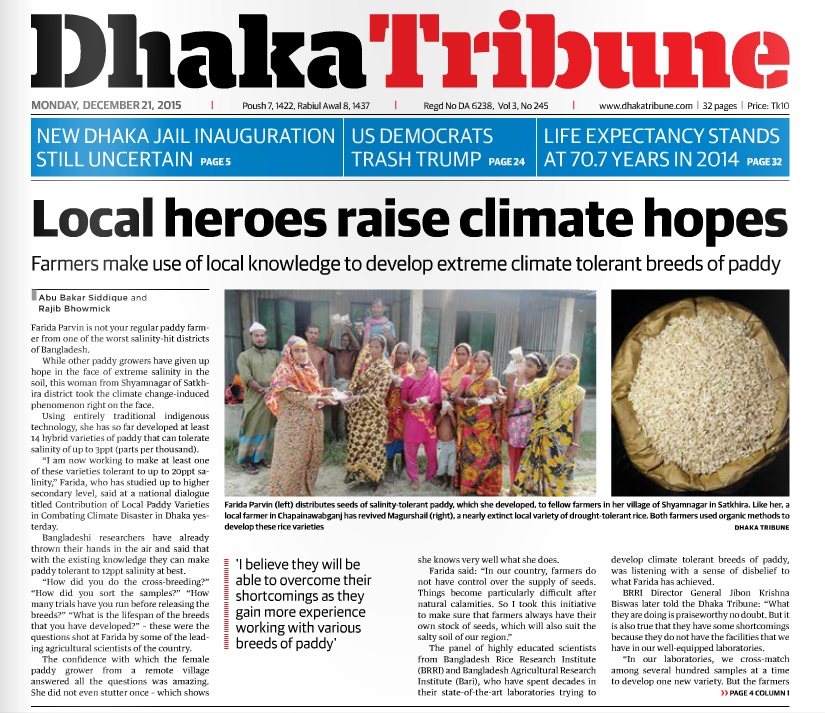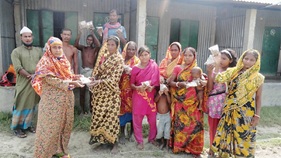:: Abu Bakar Siddique, Rajib Bhowmick
- Farida Parvin (left) distributes seeds of salinity-tolerant paddy, which she developed, to fellow farmers in her village of Shyamnagar in Satkhira. Like her, a local farmer in Chapainawabganj has revived Magurshail (right), a nearly extinct local variety of drought-tolerant rice. Both farmers used organic methods to develop these rice varieties
Farida Parvin (left) distributes seeds of salinity-tolerant paddy, which she developed, to fellow farmers in her village of Shyamnagar in Satkhira. Like her, a local farmer in Chapainawabganj has revived Magurshail (right), a nearly extinct local variety of drought-tolerant rice. Both farmers used organic methods to develop these rice varieties
Photo- Dhaka Tribune
Farida Parvin is not your regular paddy farmer from one of the worst salinity-hit districts of Bangladesh.
While other paddy growers have given up hope in the face of extreme salinity in the soil, this woman from Shyamnagar of Satkhira district took the climate change-induced phenomenon right on the face.
Using entirely traditional indigenous technology, she has so far developed at least 14 hybrid varieties of paddy that can tolerate salinity of up to 3ppt (parts per thousand).
“I am now working to make at least one of these varieties tolerant to up to 20ppt salinity,” Farida, who has studied up to higher secondary level, said at a national dialogue titled Contribution of Local Paddy Varieties in Combating Climate Disaster in Dhaka yesterday.
Bangladeshi researchers have already thrown their hands in the air and said that with the existing knowledge they can make paddy tolerant to 12ppt salinity at best.
“How did you do the cross-breeding?” “How did you sort the samples?” “How many trials have you run before releasing the breeds?” “What is the lifespan of the breeds that you have developed?” – these were the questions shot at Farida by some of the leading agricultural scientists of the country.
The confidence with which the female paddy grower from a remote village answered all the questions was amazing.
She did not even stutter once – which shows she knows very well what she does.
Farida said: “In our country, farmers do not have control over the supply of seeds. Things become particularly difficult after natural calamities. So I took this initiative to make sure that farmers always have their own stock of seeds, which will also suit the salty soil of our region.”
The panel of highly educated scientists from Bangladesh Rice Research Institute (BRRI) and Bangladesh Agricultural Research Institute (Bari), who have spent decades in their state-of-the-art laboratories trying to develop climate tolerant breeds of paddy, was listening with a sense of disbelief to what Farida has achieved.
BRRI Director General Jibon Krishna Biswas later told the Dhaka Tribune: “What they are doing is praiseworthy no doubt. But it is also true that they have some shortcomings because they do not have the facilities that we have in our well-equipped laboratories.
“In our laboratories, we cross-match among several hundred samples at a time to develop one new variety. But the farmers cross-match among only a few. So, it would be too early to predict the long-term success of their endeavours.
“Then again, I believe they will be able to overcome their shortcomings as they gain more experience working with various breeds of paddy.”
The programme was jointly organised by Bangladesh Resource Council for Indigenous Knowledge (BARCIK) and the Christian Commission for Development in Bangladesh (CCDB).
While talking to the Dhaka Tribune, Farida said she took a two-day training from BARCIK on traditional techniques of cross-breeding back in 2011. Following five-year trials of each of her 14 breeds, she has recently released six of those to her fellow local farmers, who are cultivating them now.
Farida was not the only local hero who came to the Chhayanaut at Dhanmondi yesterday to attend the dialogue.
Take, for example, Yusuf Molla from the northern drought-prone district of Chapainawabganj.
He already has a collection of around 300 indigenous varieties of Aman, Aush and Boro paddy and he has been cultivating around 100 of these rare varieties – including Dadkhani, Raghushail and Magurshail – for many years to keep them alive.
Yusuf brought gifts of 1kg of Magurshail rice – a nearly extinct low-irrigation variety – for everyone attending the programme yesterday.
In his area, underground water level has gone down alarmingly, making irrigation expensive and challenging. So, he has been trying to popularise these low irrigation varieties among the local farmers.
Nuaj Ali Fakir, not as educated as Farida or Yusuf but no less knowledgeable, from the marshland-dominated Habiganj district has discovered a new variety of paddy that can tolerate stagnant water and flash flood. He named the variety “Churak.”
He told the Dhaka Tribune that he found this rice, which stands taller than an average human being, from among a collection of unnamed paddy.
Nur Mohammad, from Rajshahi, is now awaiting approval from the Seed Certification Agency (SCA) for one of his cross-matched fine grain aromatic drought-resistant rice variety.
At yesterday’s programme, Jibon Krishna Biswas, DG of BRRI, asked Nur Mohammad to send all his cross-matched breeds to his organisation and promised to get them approved by the SCA upon scrutiny.
In his speech, Jibon said indigenous varieties and local inventions can play an important role in coping up with the changing pattern of climate.
At present, BRRI has a total of 8,044 paddy samples in its germplasm centre and 4,600 of these are indigenous.
BRRI has developed seven salinity-tolerant, four drought-tolerant and two submergence-resistant breeds of paddy. The DG said that the term “high yielding variety” has now become obsolete; they now call these “modern varieties.”
Earlier, the programme began with a lively presentation by BARCIK coordinator Pavel Partha, who showed some of the most interesting and unique but traditional usage of paddy.
For example, Binni rice is an indispensable part of wedding among the Garo. The stickiness of the rice is symbolic of the bonding in marriage.
Farida Akhter, executive director of Policy Research for Development Alternative (Ubinig), discussed why thousands of local varieties of paddy have become practically extinct.
She said this began during the Ayub Khan-era Green Revolution in the 1960s when the then government promoted high yielding dwarf varieties of paddy instead of the local breeds.
Source: Dhaka Tribune
– See more at: http://www.dhakatribune.com/bangladesh/2015/dec/21/local-heroes-raise-climate-hopes#sthash.PpC70CYP.ClgQFgjo.dpuf



